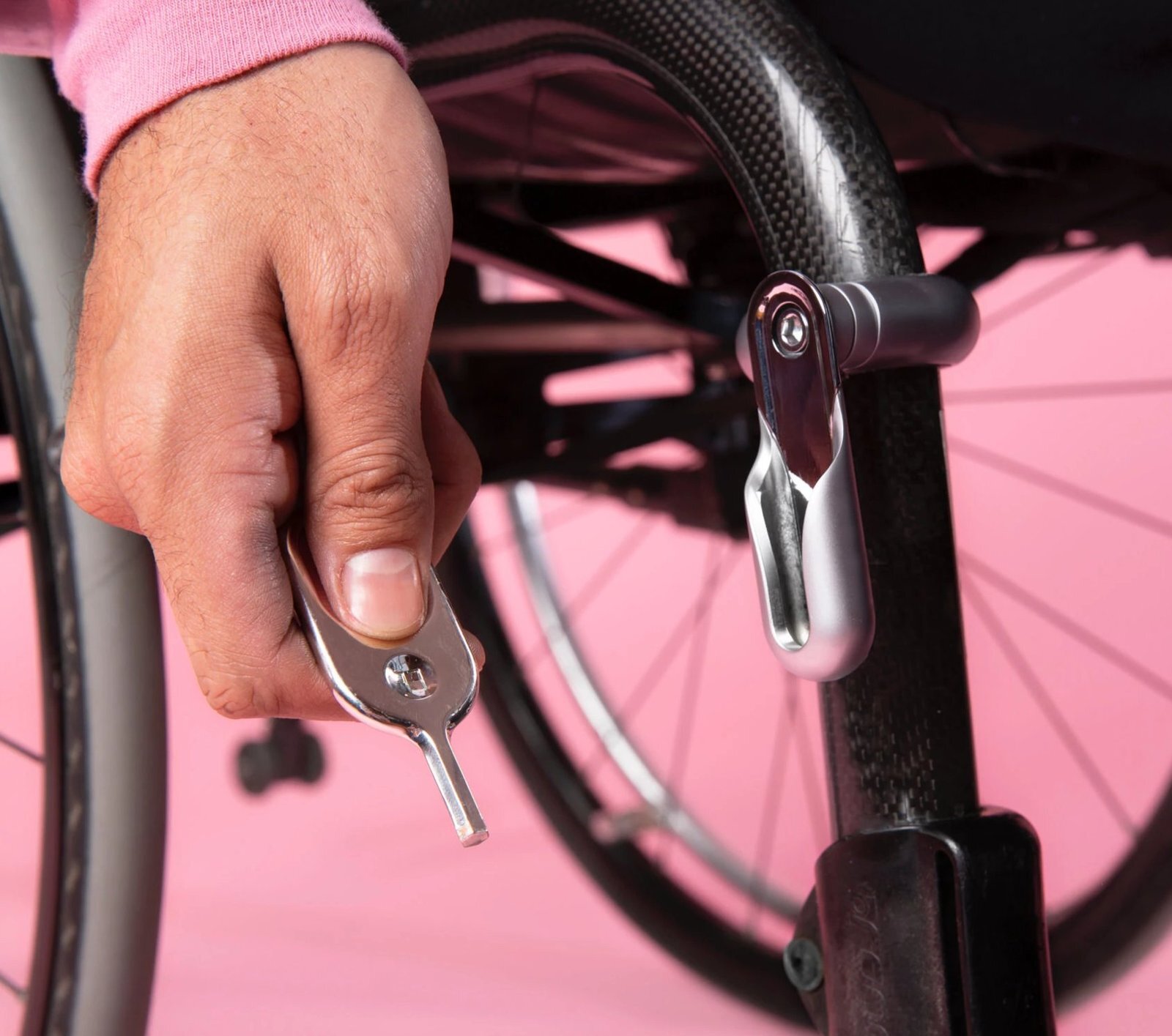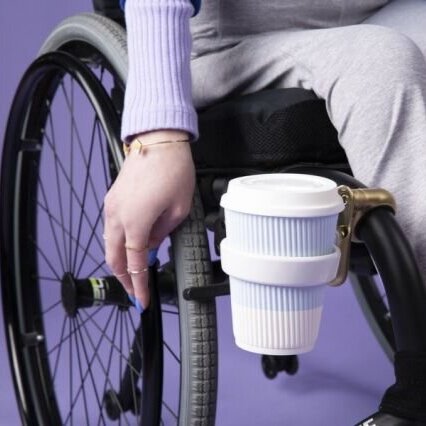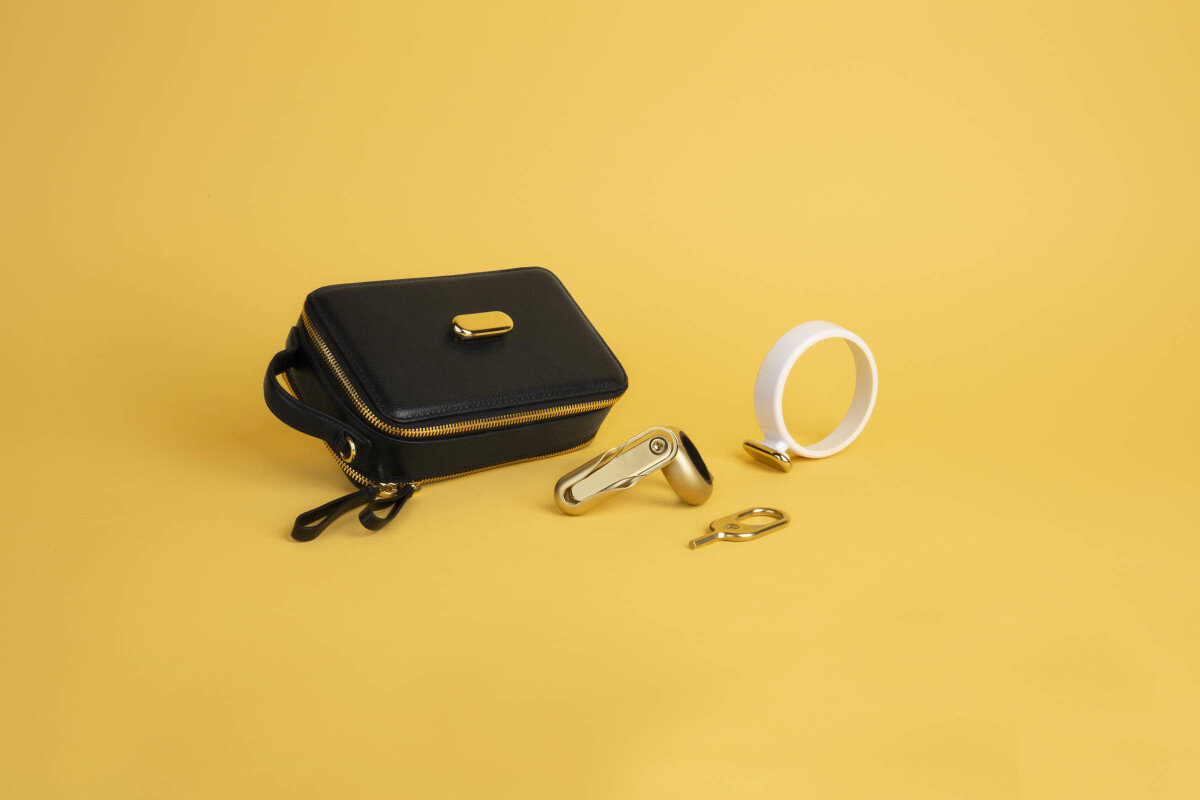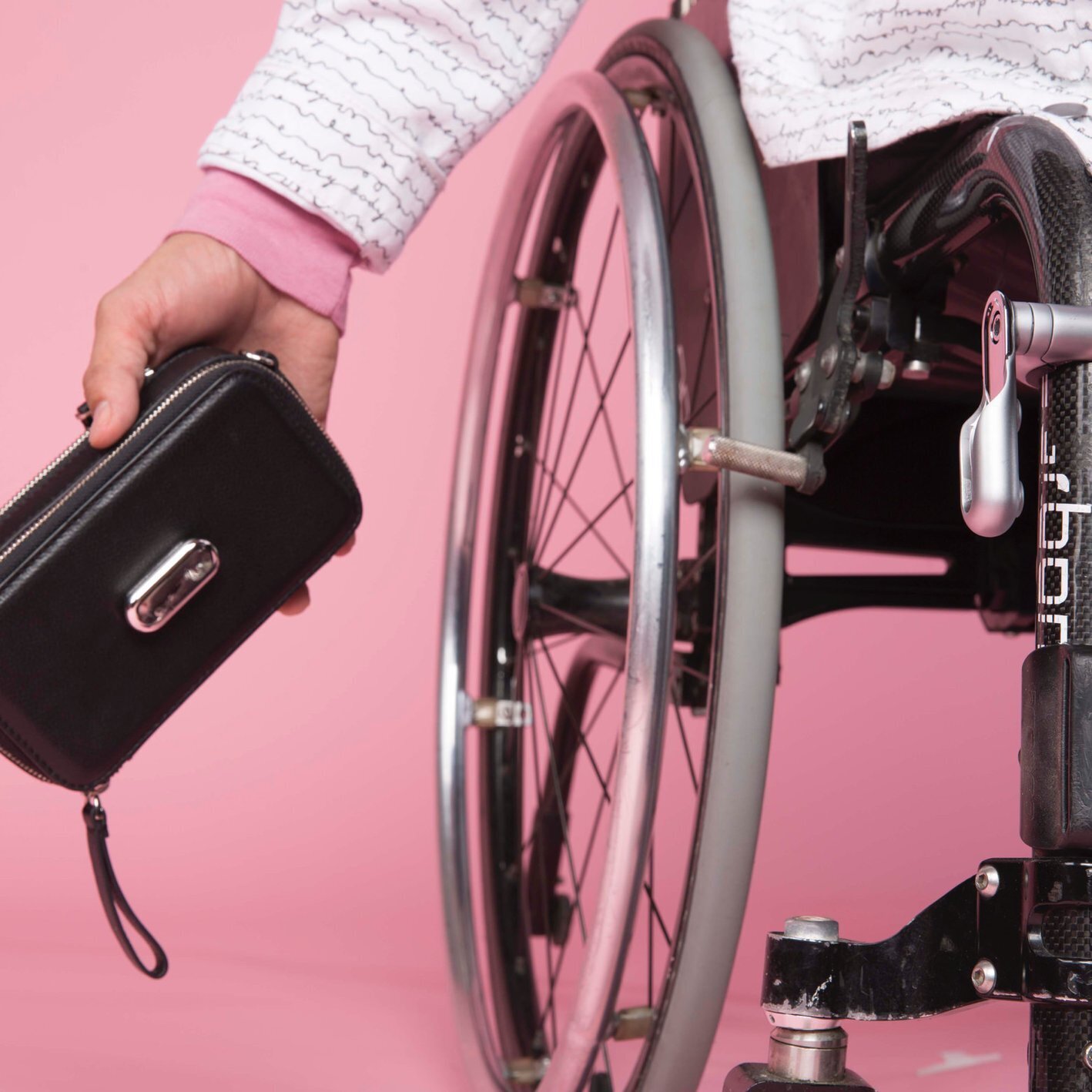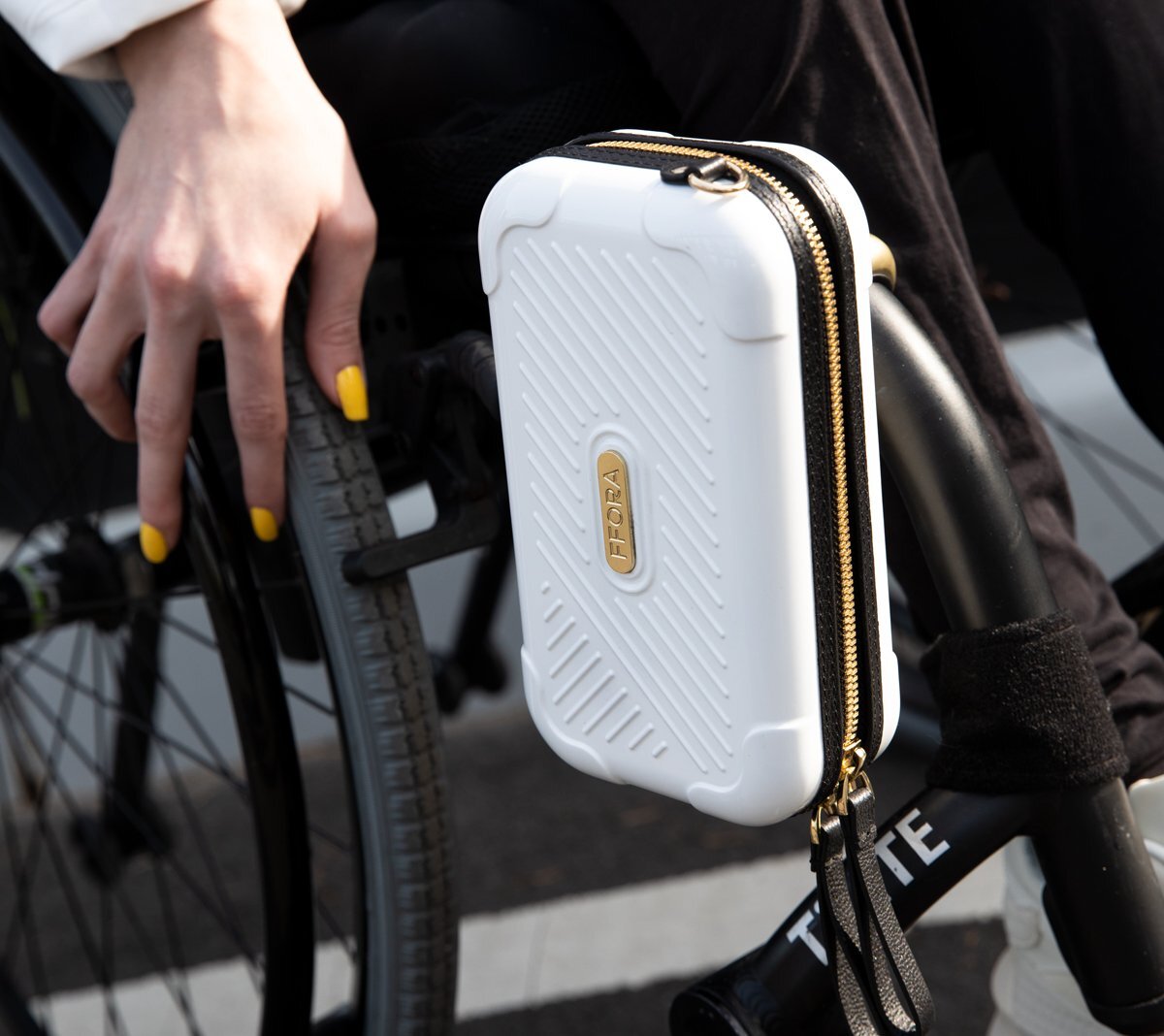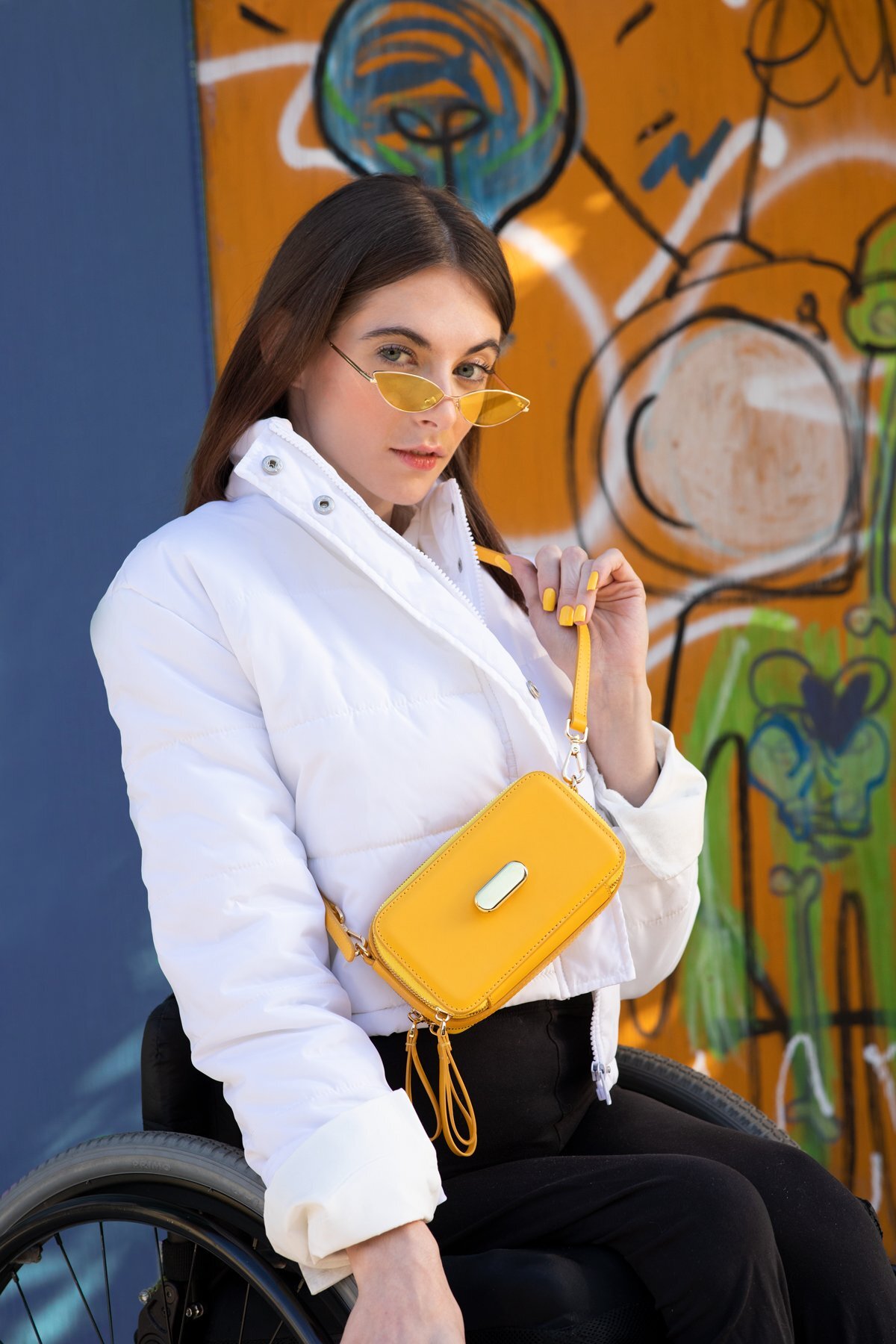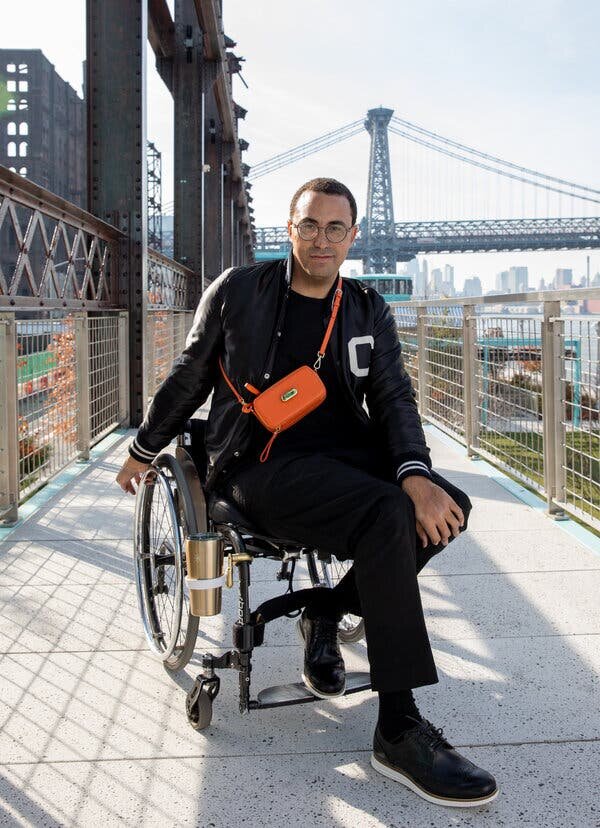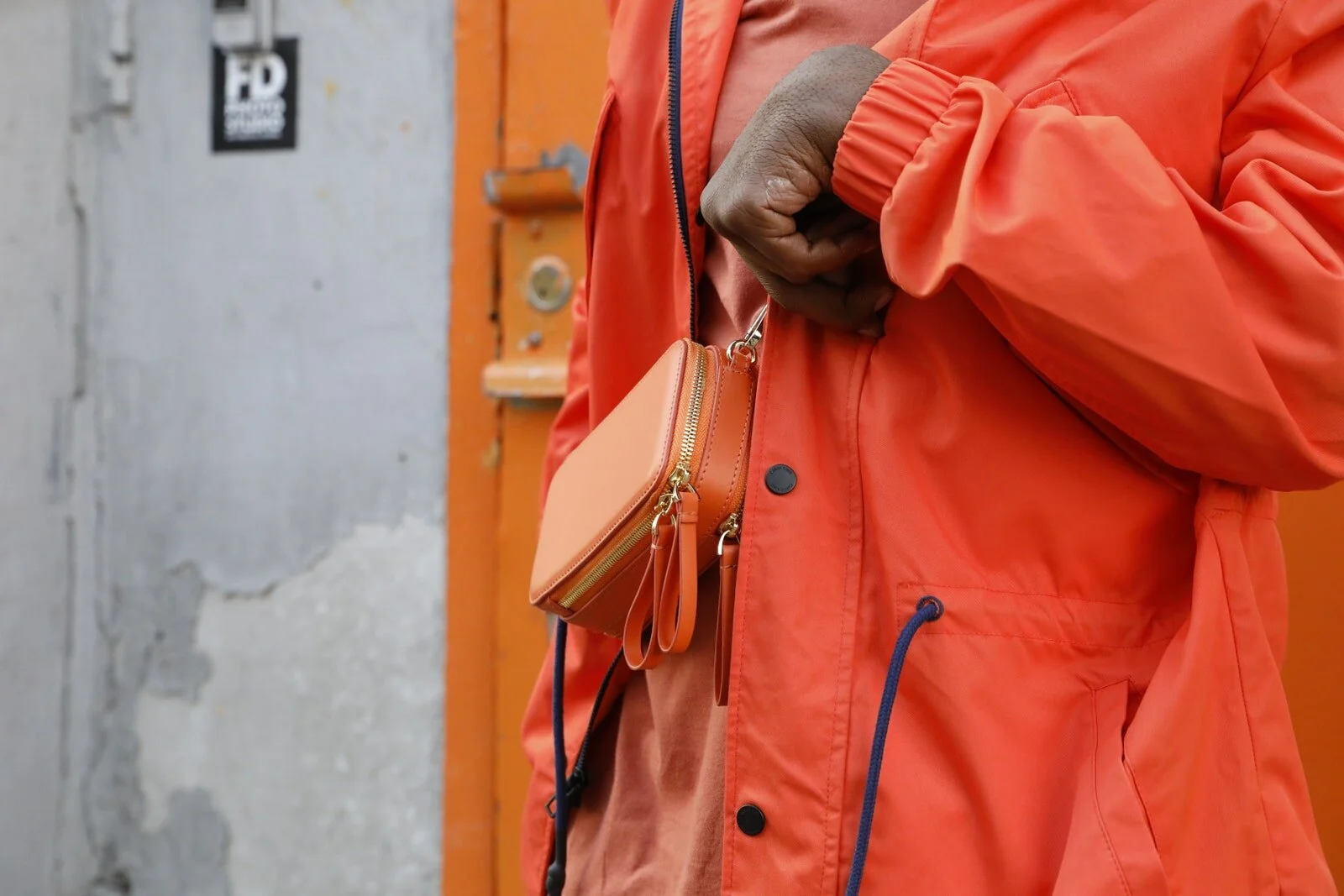Girl Talk: FFORA And The Future Of The Fashion Industry - Part I

To say I am excited about this post would be quite the understatement. Months ago I sent an incredibly long email to Lucy Jones, the founder and CEO of FFORA, describing how I was inspired to change the fashion industry after reading the September 2019 issue of British Vogue. That email sparked an ongoing friendship and dialogue about how the fashion industry already is and could be more inclusive towards people with disabilities. I recently sat down with Lucy for one of the most incredible conversations I have ever been a part of. Our conversation was so rich that I had to break it up into two parts. Part I introduces Lucy and explains how FFORA came to be the brand it is today. Thank you Lucy for agreeing to talk to me and sharing your wisdom and expertise.
JILLIAN: Thank you so much for doing this. Please start by introducing yourself.
LUCY: My name is Lucy Jones. I’m British, (but I’m not English). I’m Welsh and I moved to New York in 2011 with one goal: studying fashion design. I was accepted to do my undergraduate degree in fashion design at Parsons. Really early into my degree, I realized that there was so much stuff, so many repetitive lines and products. At the same time I was going through an identity and cultural shift of not knowing where I fit in and also feeling like I didn’t fit in. I would say that the fashion industry is very exclusive, and I wanted to hear from people who aren’t thought of or represented in fashion. Very early on in my undergraduate degree I started speaking to a family member who has cerebral palsy and that was the first time I had ever spoken about dressing challenges. To me, that said a lot. It gave me a lot of shame in myself that I had never spoken about this with him before. To me, that felt like a big problem in itself. After hearing about his personal experiences and listening to him, I entered this whole world of “I know nothing. I absolutely don’t know anything.” I would look at a mannequin, which is usually a size 6 sample-size, in standing form, faceless, anonymous, and ask “Who are we designing for?” So, that’s where this passion of talking with people who have disabilities and the disability community at large started to pepper into my undergrad and it carries on to this day.
JILLIAN: When did you know that you wanted to be a fashion designer?
LUCY: I didn’t know fashion design was a real occupation. I think it’s because a lot of people frown upon fashion as if it’s shallow (I’ll admit I go back and forth with this well). Oftentimes it can be really cutthroat and you often face old-school elitism and classism. So, for me, I would swing back and forth thinking that it wasn’t a real profession. From the age of 7, I used to arrange and cut-up clothes. To me, it was me expressing myself as a child and playing with clothes in a way to change who I was that day or feel something different another day. That was so much fun playing dress-up. When I was around 11 to 13 years old, I was given a sewing machine because I was constantly cutting things up, playing with my wardrobe- things I no longer fit into or things I no longer wanted to wear. I would always assemble and mash clothes together. It became this crafting hobby that I had- to repair things and, even when I was going out with friends, I would make an outfit to go out with my friends. I even made my own prom dress, because I didn’t like anything else that was out there. It was around that time when I really started to think “Oh, I really love fashion.” But, I was more interested in how fashion made me feel, to be able to change how I felt that day just by putting on a certain outfit, I think that is really powerful, and everyone deserves to feel that way.
JILLIAN: I love that. Who are your fashion inspirations?
LUCY: That is wild. Okay, so this is where I contradict everything. I say I’m not sure about the fashion industry but my fashion icon is Alexander McQueen.
JILLIAN: SAME!
LUCY: Ah, Alexander McQueen, one of the greats! I think I am just honored that I grew up and lived through his era of what he did for the fashion industry. I also think that his tragic departure, made us look at fashion almost with new eyes. It made us ask “Is it toxic? I think it really did pull the curtain down. I think it was just one of those events that everyone knew about. Anyway, Alexander McQueen, one of the greats. I started having a passion for design and the architecture of the body because of a number of Japanese designers. I got to see Thirty Years of Japanese Fashion in London, an amazing exhibition, and I just remember thinking, “I cannot believe I didn’t know what fashion was about. This is fashion.” Issey Miyake, for me, was someone who I just thought was a pure magician with what he did with clothing and the engineering of the garments.
Fashion heroes, for me, are also everyday people. Not just the designers you read about. I love seeing people expressing themselves, in whatever way they want! That truly is the best part of fashion. People do inspire me.
JILLIAN: I love that because no one really says that. No one really thinks that.
LUCY: I just think that there are so many people who just know how to dress well, and you don’t hear about their stories!
JILLIAN: Incredible. You said that you realized at Parsons that you wanted to venture into adaptive design. Do you remember if there was a specific moment or a specific class where you were like “This is what I want to do?”
LUCY: It wasn’t just one person, it was a series of classes and number of things. I think there were four different classes where, for any project brief I was given, I would try and make it fit this passion. There was one teacher who was the one who said “Design a solution that would change the world” and that’s how I was able to really push this conversation and have that honest conversation.. There were other classes where, I can’t remember the exact brief, I had sent one of my professors this crazy long email. Bless teachers because students are so passionate, but some of the emails they receive are so long because of the passion, quite like the one you sent me Jillian.
JILLIAN: I’m sorry it was so long.
LUCY: But, it’s so amazing to see the passion and we talked about this before: your passion was just incredible. It was incredible. It was completely electric and I was like “I need to meet this girl. This is an amazing email to receive.” It put a big smile on my face.
Anyhow, around 2014 was when I really kicked it off the projects. I spent the year doing my thesis after reading the Alexander McQueen Dazed and Confused 1998 guest editorial. For me, I wanted to really explore Disability & Fashion. Then it merged into Seated Design, which was a collection of pieces designed for the Seated Body.
JILLIAN: Yes, which I loved. Was adaptive design taught in school?
LUCY: No. What I love about the professors that I’ve had is that no one had pretended to be an expert. I was so lucky. I never had professors who were like “This is wrong. This is right.” There was so much trust that we were going to figure it out. For example, when I started working on trousers for a seated body, the pant garment blocks just look entirely different to a standing body. There was just so much trust, which is what I think education should be about: not frightened of not being an expert- delving outside of your norms, I think that’s where the real dialogue and magic happens.
When I started my research, I didn’t know the term “adaptive design” at the time. I googled “accessible clothing” and I was met with things that, as a fashion student, I was a bit horrified by. I felt that what I was seeing was almost an insult to people if these are the only options. But there was the designer, Izzy Camilleri, who I got to meet, and I just thought she was awesome. Izzy Camilleri had a line in Canada, I think it was called Iz Adaptive then (It is IZ now). Shortly after, there was a whole group of people who were situated in New York who were finding each other, I remember being on an email chain with a whole group of disabled and non-disabled people, and just talking about what we were going to do to push the conversation forward. I admit I was still feeling very lost and confused, as most recent grads sometimes feel, but there was this group of randoms who had found each other for a similar goal and we’re all still connected in some way, all these people are out there doing things. That was very, very cool to see.
JILLIAN: Where did FFORA come from?
LUCY: I wish that in fashion education, and in education in general, there was far more collaboration, because FFORA came about after realizing that I didn’t have all the skill I needed to design an accessories collection. I had done a smaller accessories collection and a lot of people had said that I have a natural flair for accessories. I lived in Paris for a short time and one of my professors was a senior accessories designer at Louis Vuitton. I remember her saying to me, “Lucy, you have a flair for accessories,” and I would respond, “No. No, I don’t. I don’t want to do that.” But accessories are magical to me, because it is more mathematical, the level of detail that goes into designing one little piece is exciting. Whether it’s a little handle or a clasp, I like that hard material. but previously I just didn’t have the time, resources, or the know-how. After talking with people we really understand that a wheelchair can often be integral to self-expression. Some people say it’s not, some people say it is, some people refer to wheelchairs with names and it’s a part of them. And why not, no matter what it means to each person, or whatever the preference, it’s about choice and there should be choices. So therefore “Can it be part of the design conversation? Why is this not part of the fashion conversation?” That’s how it came about.
The other is the reality of brands that have tried to do “adaptive clothing” and failed or have gone out of business. There is that harsh reality that brands have missed the mark, got it wrong, or maybe not had the exposure they deserved and they’ve gone under because no one knew they existed. We are not the first, at all, there were many many before us, and that has been a shame that some people get recognized and some people don’t. But I believe a transformative or expandable idea can start with one concise collection. Louis Vuitton (not that I can afford it) was built on this idea, this fantasy of travel and going places or, even if you are staying put, feeling like you are being transported somewhere else. That feeling, that expression is so important. They (Louis Vuitton) started with a five piece luggage collection. I ask myself now, “What would Louis Vuitton do if they started a brand today?”
JILLIAN: Exactly.
LUCY: So it’s this ability to grow beyond accessories and defining what the brand means as a whole.
JILLIAN: Wow, that was a great answer. Where did the name FFORA come from and what does it stand for?
LUCY: People think it stands for “Fashion For All”. That’s truly cute, but that’s not where it comes from. The name “fora'', spelt F-O-R-A, is the Latin plural for the word “forum”. FFORA is not possible without listening, without dialogue, and without involving and directly working with people who have the expertise and lived experience. To me, that stood for something. The name could have been anything, but it needed to encompass that feeling of coming together. A public forum is a place where you go to speak your mind and say your truths and I felt that that was really what the brand is about.
I called my father and I said, “Dad, the name is FFORA. It is spelled F-F-O-R-A. There was this massive pause while he thought about it, and then he said, “Brilliant. Fashion for all, love it.” And my jaw dropped. (At this point both of us are laughing) So, it was my dad who said that to me and then I shared the fun story with other people and it just spiraled out of control. It was one of those things where I’m like “No! That’s not what it is! My dad said that!” But, it was so sweet because it’s true.
JILLIAN: I love that it works both ways.
LUCY: Yes. The double-F is so fun because a lot of people always ask about the pronunciation and it’s like an inside joke. They are like, “Is it F-FORA?”. I have a friend, who knows how to say it properly, but he still calls it F-FORA just for fun and to annoy me. He’ll call me up and will ask, “Hey Luce, how is F-FORA?” and my response is “Stop it! You know!”
It is what it is to different people which is also kinda cool. The fact that people refer to the bags as a “FFORA” or a product as a “FFORA” is just magical to me and so humbling. It feels like true ownership, the fact that people are owning the word. It is something that you only wish could happen, but is like a phenomenon if it ever does!. So, people asking “Where are you putting your FFORA? How do you position it? How are you wearing it?” and I think that is pretty incredible to hear those expressive conversations using the name. We truly have the best community!
JILLIAN: When you were sketching and designing, which came first? The handbag or the attachment?
LUCY: Oh gosh. It wasn’t the handbag design at all. Joonas, who is the head of industrial design is also the secret sauce. But talking came first, the dialogue came first- it was meeting with friends, meeting with people, and really understanding the holistic view of how people live and move through life and what people wanted to see. We knew we couldn’t have something clunky, in the way or huge. It had to be something discreet yet robust. Actually, I believe the first thing that was created was the cupholder. I remember one day I walked into the studio and the 3-D printer was going. It was a constant tweak, but one day I remember seeing that little pebble shape which Joonas had printed. I remember holding that little pebble, which is the magnet that goes onto the bag, in front of Joonas like I was Jack (from Jack and the Beanstalk) holding those magic beans. I was like, “OMG, this is it.”
After testing and seeing how intuitively it behaved- it’s the most abstract form- but, it just made sense. Kids are obsessed with it- a lot of customers have said their kids have nicked it or stolen it from them to play with. I think that’s quite funny because it is playful.
JILLIAN: Exactly. I love your bags. I do not need a wheelchair, but I’ll wear it everywhere. When people compliment me on the bag I will tell them that it is also functional, it is accessible, there is a purpose to the design.
LUCY: I love that! I love inside jokes and I love that this is a nod, like we’re in on something together.
JILLIAN: I love that one little thing can teach so much.
LUCY: It can be an icebreaker. And, you know, there is still a long way to go. Sometimes I am disheartened because there is still such a stigma. It is infuriating, even being in New York and working in Manhattan. You realize that there are so many people and there is so much further to go.
JILLIAN: When you launched, how did the disabled community respond?
LUCY: I think we have been so lucky that we’ve gotten to work with incredible people and launch with the community.When we rolled it out it was incredible, the response was amazing. Of course, there were learnings. There are always learnings. There are so few companies that put investment into disabled people that we now carry this pressure knowing we might be this little piece of history. We will always be looked back to and criticized. But, we knew that going into this and that was part of putting something out there and taking on the risk and all the sleepless nights- to know we are doing something and, of course, hoping to learn as well. I think it was really good that I always look back and say “Things could have been done better” but, to be honest, the overwhelming response has been very positive.
JILLIAN: How did fellow fashion designers and the fashion industry respond when you launched?
LUCY: The fashion industry has been really responsive. The annoying thing to me, still, is this blurring category of “Are we fashion?” I don’t know Jillian. What do you think? Are we fashion? Are we part of the fashion industry?
JILLIAN: Yes, 100%. To me, fashion is everything that you put on your body including clothing and accessories. That is how you are presenting yourself to the world that day. Fashion is from head to toe. People, myself included, consider what accessories they are wearing with every outfit, especially someone in a wheelchair. Their mobility is different and they have to figure out how they can hold their purse and have it not be in the way, but also have something that suits their taste. So yes, absolutely, accessories are a part of the fashion industry and should be a part of the conversation because if this is what you are doing with handbags, what else can we design?
LUCY: Exactly. I do believe it’s fashion. I believe that this is still a complicated area, even with the designing of the wheelchair, mobility device, or anything that is considered a device rather than an accessory, maybe it should be, maybe it shouldn’t Eyewear was considered a medical apparatus- even the terminology for eyewear has changed. Hearing aids, I mean, look at air pods. There has got to be some design considerations going on, I know there is and it’s a shame that I don’t know enough. To me, the biggest shame is when people refer to FFORA as a utility brand.
JILLIAN: No, no.
LUCY: It is important to note that this feedback does not come from the disabled community. Rather this might be feedback from people in the fashion industry. My response is “No.” But, why can’t utility be fashion as well?
JILLIAN: I think it can be. I certainly don’t see why it can’t.
LUCY: Exactly. It is almost like they are so separated for no reason.



